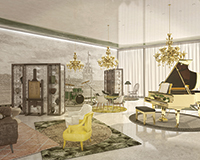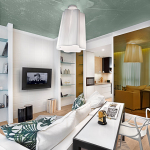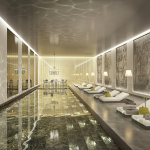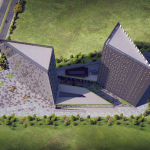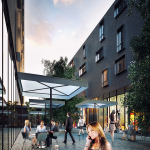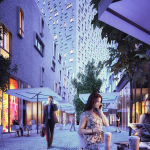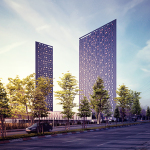A building site just off one of Istanbul’s most choked highways is not where you would expect to find one of the world’s best-known luxury design brands. But that has not deterred Philippe Starck. Emily Wright met Mar Yapi, the developer behind the city’s new Yoo residential scheme, to find out more
The western outskirts of Istanbul in the 40°C July heat offer very few redeeming qualities.
How a four-lane highway can be packed with six lanes’ worth of traffic and miraculously avoid gridlock is beyond belief. But the Metro line does not yet stretch to this part of the city and no one is prepared to sit and wait just because there are several thousand other cars between them and their destination. And so a terrifying 50-mile jostle along the length of the dusty motorway ensues.
Lay-bys and grass verges become bone fide areas for high-speed overtaking and/or undertaking and the central reservation is seen less as an official barrier and more as a suggestion as those drivers in particularly beaten-up vehicles screech right up against it, paintwork and sparks flying. Men with carrier bags full of bottled water – many of them Syrian refugees – stand, unflinching, with thousand-yard stares, straddling the universally ignored lane markings amidst the vehicles and exhaust fumes.
And mile upon mile of bleak, industrial-style buildings and abandoned offices line the choked artery between the heart of historic Istanbul and the airport.
Welcome to the location of Istanbul’s hotly anticipated luxury residential boom. According to local developers, architects and investors, this fume-filled suburb is set to become the next big destination for the world’s high-end hotel and residential brands as a young, wealthier population fuels the city’s status as the fastest-growing in Europe.
There is one name at the heart of the area’s regeneration story – Yoo. The Philippe Starck-inspired brand has become synonymous globally with affordable luxury design.
And Turkish housing developer Mar Yapi is now on site a stone’s throw from the expressway with G by Yoo, a 1m sq ft, 721-flat scheme due for completion in 2017. The developer hopes it will cement Istanbul’s prowess as a major player in European real estate development.
But is there an appetite for it – in the city generally and out in this western suburb? There may be a bold vision for the future, but to say there is a long way to go is an understatement. And with political instability deterring some overseas investors, is the time right for a scheme of this size and style?
Here Robert Varon, Mar Yapi’s development director and the man leading the delivery of the G by Yoo towers, makes his case.
It soon becomes apparent that the Mar Yapi HQ is a design-led diamond in the Bagcilar region rough as the sweltering cab turns off the highway and into a nondescript business park. Nondescript, that is, bar one building.
From the perfectly manicured green lawns and potted bay trees in front of the building to the clean lines and floor-to-ceiling windows, the developer’s office looks unlike anything else in the vicinity. The huge, upside down black-and-white photograph of Philippe Starck himself – which has been built into the top window above the front entrance – completes the look.
When it comes to property development in this area of Istanbul, it is clear these guys are ahead of their time by some way. Any office that boasts a pet parrot called Chico has a certain reputation to live up to – even by London standards.
Innovative company
“We have used brands like Yoo as leverage to become an innovative company in Turkey,” says Varon. “Philippe Starck is a very important name in Turkey. All Yoo projects are in, or close to, premium locations.”
The development is being built a 10-minute drive from the Mar Yapi offices and a quick glance out of the window is enough for Varon to be able to anticipate the next question.
“Yoo did have questions at first,” he says. “This area is still in a development phase. But it is a huge regeneration area. It will change massively in 15 years. The project is on the road that will lead to the new, third airport and in the next three to four years this whole area will see 27 new hotels.”
Like London, the Istanbul map is changing fast, says Varon. Areas that were once considered fringe are becoming core, thanks to infrastructure upgrades and development being pushed out of central areas. “Without the traffic, this area is 15 minutes away from the city centre,” he points out.
But therein lies the problem. There is major traffic almost constantly. And the Metro is not sophisticated enough in this part of the city to support a proper community. “OK, maybe we shouldn’t talk about the traffic,” laughs Varon. “But that is why the Metro upgrade is vital. It has been overlooked for years here, but there is now huge government investment.”
But once the case for the area has been presented, there is a wider issue to discuss – the level of investment into Istanbul and Turkey as a whole, against the backdrop of geopolitical instability. But Varon is confident the market can survive the volatility.
“There are ups and downs, of course,” he says. “We are right between the Middle East and Europe here. And the political situation now, especially with what is happening in Syria, is maybe making people nervous. But Istanbul is actually quite detached from all of that.
“We are miles from the south-eastern border and the dynamic here is very different. We may see some slowdown from overseas investors for a while, but I don’t think it will impact on us too much.”
Delivery for demand?
As for whether there is an appetite for the Yoo scheme, the figures do suggest there is demand. Only one of the two 35-storey towers – both will be completed by 2017 – has gone on the market and, within nine months, 50% has been sold.
There is a big draw in the fact that, as the project is in the affordable luxury category, prices currently average $1,000 (£654) per sq m. This compares with an average of nearer $13,000 per sq m for luxury residential closer to the city centre and the Bosphorus.
As regards to who is actually buying the flats, Varon is quick to insist this is not a case of foreign money piling in to pick up this type of property, pushing local people further out of their own market. “Just under 90% of the buyers so far have been domestic,” he says. “The 10% overseas money has been mainly from the Gulf region. The brand really helps. It is well-known across the world and people trust it.”
And when it comes to questions about oversupply, Varon remains bullish. “Turkey is a very young country,” he says, “and Istanbul makes up 30% of its GDP. We have lots of students in the city going to private universities. We can target people who work for international companies who want to be close to their HQs.
“Our target audience is white-collar people, young people and investors who want to put money into something that will appreciate fast. The niche element is our USP.
“There are developments in Istanbul of 3,500 flats. There is nothing unique about that. You have a huge gated community with a pool. At that top end, you have a saturated market. They are asking for $10,000, $11,000, $12,000 per sq m. And they can’t shift those.
“But this? In an up-and-coming area near the airport with a brand like Yoo at around $1,000 per sq m? This will sell. There is a need and a demand.”
Varon adds: “Istanbul is a very tough city sometimes. It is hectic and chaotic. We can offer a certain lifestyle for people here, via a brand they have heard of. We can offer them a look and design that isn’t common here yet.”
And what about that design? How will the Starck style be stamped on to these properties? They will be the first triangular composition buildings in the city. “It is a brave move,” says Varon. “It is very unusual in this market. But it reduces the number of flats facing north. People don’t like that because they are facing into northern winds and away from the sun.
“The interiors will have the Yoo feel, but using Turkish elements. So Turkish motifs and hand-woven carpets. And they will fit into one of two moods – nature and culture.”
The amenities will include an outdoor pool, entertainment room, business lounge, mini cinema, basketball court, fitness centre and spa. But although it will be a beacon of luxury living, there are certain elements that seem beyond the realms of possibility.
The lush forest surrounding the building in the image of the outdoor pool, for example. Rather green for such an urban landscape? “Yes,” Varon concedes. “Well, that is more of a CGI green than a real green.”
Surge in development
For anyone who has suffered the drive from the city to Mar Yapi’s offices, Varon’s forecast of a surge in development and regeneration in this suburb might seem far-fetched.
But a quick trip to the site of the Yoo scheme itself, where the two triangular towers are already rising from the ground, and banners pepper the area promising new malls, luxury hotels and myriad upgrades, does suggest big changes are on the horizon – even if it takes a lot of imagination to accept it.
“It is just like east London,” shrugs Varon. “What did east London look like 15 years ago?” He has a point.
A point that anyone less visionary could easily forget during a 90-minute journey back to the city centre via a sweltering mass of weaving traffic across six lanes on a four-lane highway.
emily.wright@estatesgazette.com
• See also
Istanbul: The effects of geopolitical turmoil on the city’s real estate market







